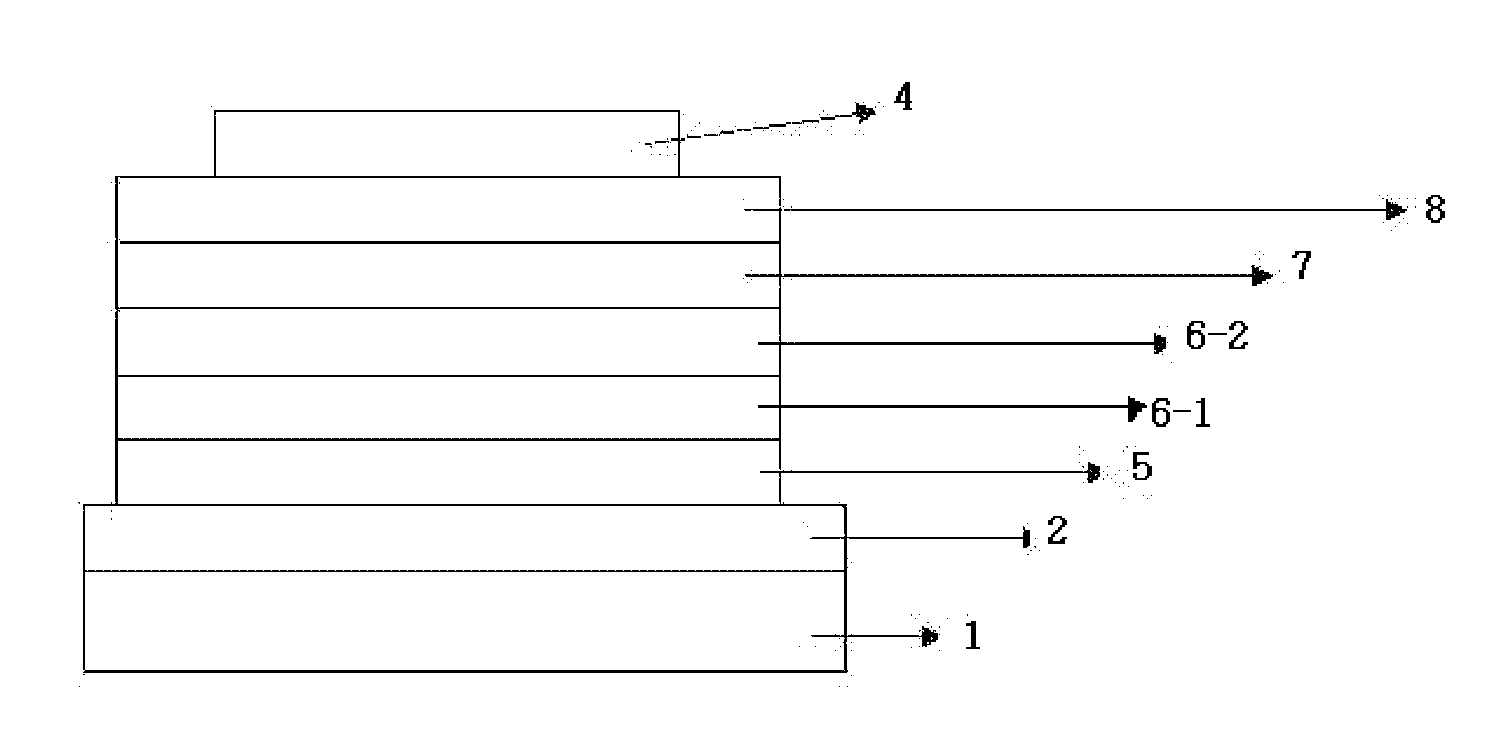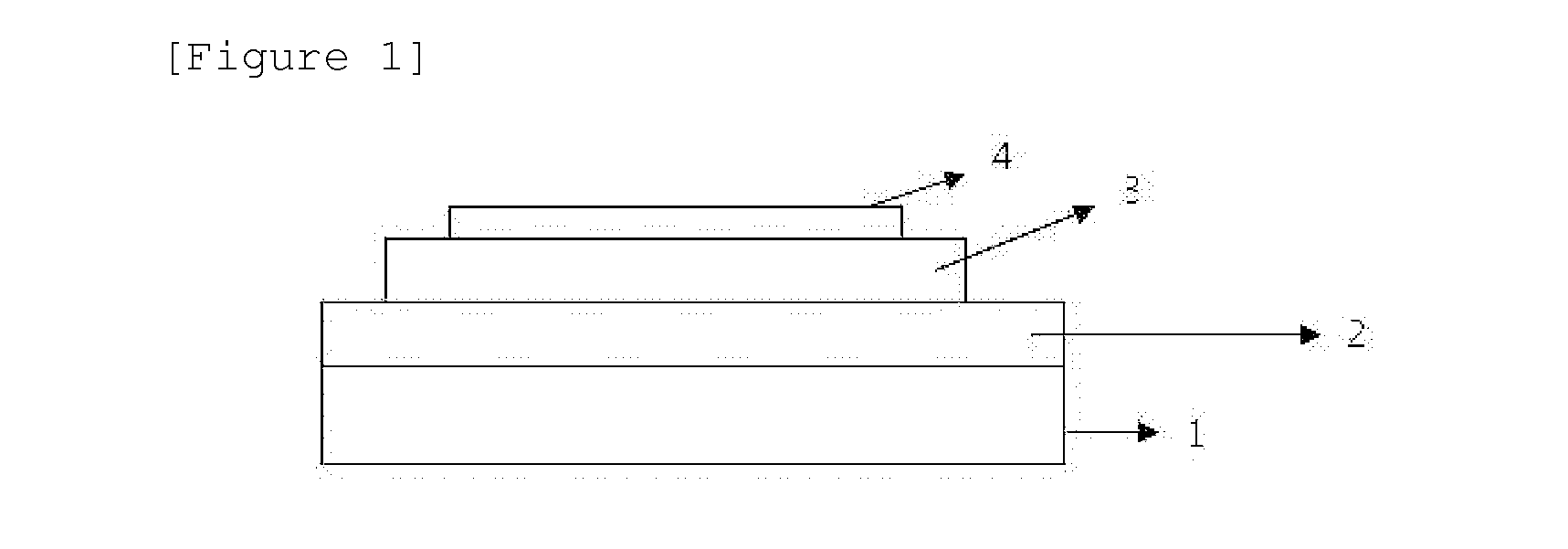Material for organic light-emitting device, and organic light-emitting device using same
a technology of organic light-emitting devices and materials, which is applied in thermoelectric devices, organic chemistry, triarylamine dyes, etc., can solve the problems of difficult to manufacture an organic light-emitting device with high efficiency and a long life span, and difficult to use npb in an organic light-emitting device requiring a high current, so as to improve the life span property of the device, reduce the driving voltage of the device, and improve the effect of light efficiency
- Summary
- Abstract
- Description
- Claims
- Application Information
AI Technical Summary
Benefits of technology
Problems solved by technology
Method used
Image
Examples
example
Synthesis Example 1
Manufacturing of the Compound Represented by Formula 1-1
[0115]
[0116](1) Manufacturing of Formula 1A
[0117]2-bromodibenzothiophene (30 g, 114 mmol), 4-chlorophenylboronic acid (19.6 g, 125 mmol), and potassium carbonate (K2CO3) (39.4 g, 285 mmol) were dissolved in tetrahydrofuran (THF) (300 mL) and H2O (100 ml) and heated to 50° C. Tetrakis(triphenylphosphine) palladium (Pd(PPh3)4) (1.3 g, 1.14 mmol) was added thereto, and then refluxed for 12 hours. After cooling to normal temperature, the water layer was removed. After magnesium sulfate (MgSO4) was added to the organic layer, filtration was performed. After concentration, purification was performed by the column chromatography to obtain Formula 1A (20 g, yield 60%).
[0118]MS: [M+H]+=294
[0119](3) Manufacturing of Formula 1-1
[0120]Formula 1A (10 g, 33.9 mmol), phenyl-terphenylamine (N-phenyl-[1,1′:4′,1″-terphenyl]-4-amine) (11.4 g, 35.6 mmol), NaOtBu (4.2 g, 44.1 mmol), and xylene (100 ml) were mixed, and then heated...
synthesis example 2
Manufacturing of the Compound Represented by Formula 1-2
[0122]
[0123](1) Manufacturing of Formula 1B
[0124]The same method as the manufacturing of compound 1A of Synthesis Example 1 was performed to obtain Formula 1B (25 g, yield 59%), except that compound 4-chlorobiphenylboronic acid (25 g, 125 mmol) was used instead of compound 4-chlorophenylboronic acid.
[0125]MS: [M+H]+=371
[0126](2) Manufacturing of Formula 1-2
[0127]Formula 1B (10 g, 27 mmol), phenyl-terphenylamine (N-phenyl-[1,1′:4′,1″-terphenyl]-4-amine) (9.1 g, 28.4 mmol), NaOtBu (3.4 g, 35.1 mmol), and xylene (100 ml) were mixed, and then heated to 100° C. Bis[(tri-tertiary-butyl)phosphine]palladium (Pd(p-t-Bu3)2) (138 mg, 0.27 mmol) was added thereto, and then refluxed for 48 hours. After cooling to normal temperature, purification was performed by the column chromatography. After drying, Formula 1-2 (7.3 g, 41%) was obtained.
[0128]MS: [M+H]+=656
synthesis example 3
Manufacturing of the Compound Represented by Formula 1-3
[0129]
[0130](1) Manufacturing of Formula 1C
[0131]2-dibenzothiopheneboronic acid (10 g, 43.9 mmol), 2-bromo-7-iodo-9,9-dimethyl-9H-fluorene (17.5 g, 43.9 mmol), and potassium carbonate (K2CO3) (18.2 g, 132 mmol) were dissolved in tetrahydrofuran (THF) (300 mL) and 100 ml of H2O and heated to 50° C. Tetrakis(triphenylphosphine) palladium (Pd(PPh3)4) (1.0 g, 0.88 mmol) was added thereto, and then refluxed for 12 hours. After cooling to normal temperature, the water layer was removed. After magnesium sulfate (MgSO4) was added to the organic layer, filtration was performed. After concentration, purification was performed by the column chromatography to obtain Formula 1C (15 g, yield 75%).
[0132]MS: [M+H]+=455
[0133](2) Manufacturing of Formula 1-3
[0134]The same method as the manufacturing of compound 1-1 of Synthesis Example 1 was performed to obtain compound 1-3 (7 g, 46%), except that compound 1C (10 g, 22 mmol) was used instead of ...
PUM
 Login to View More
Login to View More Abstract
Description
Claims
Application Information
 Login to View More
Login to View More - R&D
- Intellectual Property
- Life Sciences
- Materials
- Tech Scout
- Unparalleled Data Quality
- Higher Quality Content
- 60% Fewer Hallucinations
Browse by: Latest US Patents, China's latest patents, Technical Efficacy Thesaurus, Application Domain, Technology Topic, Popular Technical Reports.
© 2025 PatSnap. All rights reserved.Legal|Privacy policy|Modern Slavery Act Transparency Statement|Sitemap|About US| Contact US: help@patsnap.com



